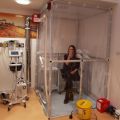Study will help guide women’s choices in where to give birth
Women with straightforward pregnancies can choose whether they’d like to give birth in a hospital obstetric unit, a midwifery unit or at home, knowing that giving birth is generally very safe. But there are some important differences between these birth settings in benefits and risks for the mother and baby, the Birthplace in England study has shown.
The findings come from a landmark study of almost 65,000 ‘low risk’ births – the first of its type and scale. It included nearly 17,000 planned home births and 28,000 planned midwifery unit births.
The Birthplace study addressed the safety, costs and provision of maternity care in England according to where women with ‘low risk’ pregnancies plan to give birth. It compared women at ‘low risk’ of complications who planned to give birth in hospital obstetric units with those who planned to give birth at home or in midwifery units.
It was carried out by the National Perinatal Epidemiology Unit at Oxford University and led by co-investigators from Oxford, UCL (University College London), King’s College London, City University London, NCT, the UK’s largest charity for parents, and the Royal College of Midwives.
The researchers say the guidance given to women in planning where they want to give birth can now be updated to take account of the study findings.
Key findings
• Giving birth is generally very safe. In straightforward, ‘low-risk’ pregnancies, poor outcomes for babies are uncommon regardless of where mothers plan to give birth.
• Among almost 65,000 ‘low risk’ births, there were 250 births where the baby had a poor outcome. That is 4.3 events per 1000 births, so these poor outcomes are rare. The adverse outcomes measured in the study included both very serious adverse outcomes, such as death of the baby during or shortly after the birth, but also conditions and injuries that can vary widely in severity.
• First-time mothers planning to have a home birth have an increased risk of poor outcomes for the baby: 9.3 per 1000 births compared with 5.3 per 1000 births in obstetric units.
• The likelihood of a ‘normal’ birth (one without interventions) is reduced for mothers planning births in an obstetric unit.
• Transfers to hospital from other birthplaces are relatively frequent, particularly among first-time mothers where more than a third (36%–45%) of mothers are transferred during labour or immediately after the birth.
• Costs are lower for births planned at home and in midwifery units than in obstetric units. A birth planned at home is £310 cheaper than an obstetric unit on average, while one planned for a midwifery unit is around £130 cheaper.
• The safety, lower costs and fewer interventions seen in midwifery units could see an increase in their number in future, although this might require an increase in midwife numbers.
• There are big differences across the country in the availability of midwifery units, and in the way maternity services are organised and staffed
• 50% of trusts had no midwifery units in 2010, which is likely to have limited the choices available to women about where they would like to give birth.
The researchers found that giving birth is generally very safe. In straightforward, low-risk pregnancies, poor outcomes for babies are uncommon regardless of where mothers plan to give birth.
There were 250 adverse outcomes for the baby, as counted by the study, among the 64,538 births. That is 4.3 adverse outcomes per 1000 births.
The researchers used an outcome measure that was designed to bring together a set of individually rare poor outcomes for the baby that might be related to the quality of care received in labour. The measure included stillbirths during labour and early neonatal deaths, as well as a range of conditions that can vary widely in severity for the baby. These were conditions associated with trauma at birth, or the baby becoming distressed or being deprived of oxygen during labour.
Overall, there appeared to be no differences in outcomes for the baby between the different planned places of birth.
However, among first-time mothers planning to have a home birth, there was an increase in risk of a poor outcome for the baby. There were 9.3 poor outcomes in every 1000 planned home births compared with 5.3 per 1000 births planned in obstetric units. So these are still uncommon events.
There was no increased risk for second and subsequent babies in planned home births.
This finding needs to be balanced against benefits for the mother. In total, 90% of mothers who planned home births had ‘normal births’, having substantially fewer assisted deliveries, Caesarean sections and other common interventions – all of which have some associated risk. That is compared to under 60% of mothers who planned obstetric unit births.
Midwifery units appeared to be safe for the baby and also to offer benefits for the mother. Mothers planning births in midwifery units saw no differences in adverse outcomes for babies compared with mothers planning births in obstetric units. Again, there were many more ‘normal births’ compared with obstetric units, at 76% for planned births at midwifery units attached to hospitals and 83% for free-standing midwifery units.
There was no increase in risk of poor outcomes for babies for mothers planning to give birth in a midwifery unit, whether they were first or subsequent births.
The researchers say that first-time mothers coming up to their due date who have plans to give birth at home should feel able to discuss these findings with their midwife. They say that there is no need for first-time mothers to change their plans as a result of these findings, unless they wish to do so or their clinical condition changes.
The team also found that transfers to hospital from midwifery units or home births during or immediately after labour were relatively frequent, particularly among first-time mothers.
Overall, between 21% and 26% of mothers planning birth outside obstetric units were transferred to hospital. For first-time mothers it was between 36% and 45%. For subsequent babies the rates were between 9% and 13%.
The fact that women can be transferred if they need more care is one of the reasons why planned home and midwifery unit births are as safe as they are, but women need to be aware of the likelihood of transfer so that they can make informed decisions. Obstetric units will remain an important part of maternity care even if the number of births increase at midwifery units and at home.
The researchers say their findings generally would support a policy of offering choice of place of birth to healthy women with straightforward pregnancies.
The study did not look at the avoidability of adverse outcomes in different settings, any effect of staffing levels or the configuration of maternity services, or provide detailed analysis of transfers.
The main part of the study is published in the BMJ.
The Birthplace study also looked at the costs of birth in each of the birth settings and mapped variation in maternity service provision across England.
A full report including all sections of the study has gone to the Department of Health.
Peter Brocklehurst, who led the study at the National Perinatal Epidemiology Unit at the University of Oxford, though he has since moved to UCL, says: ‘These results should reassure pregnant women planning their birth that they can make informed decisions about where they’d most like the birth to happen, knowing that giving birth in England is generally very safe. There is an increase in risk for first-time mums planning home births, but poor outcomes for the baby are still uncommon.’
Mary Newburn, Head of Research and Information at NCT, the UK’s largest charity for parents, said: ‘Expectant parents need support to make plans about where to have their baby, which feel right for them. Every woman wants her baby to be healthy and have a good start in life, and she needs to feel safe herself. But different settings appeal to different people. Women will think about this new information in the context of their own lives, their personal circumstances and values. The Birthplace results should mean more birth centres are opened, creating positive choices for many more women.’
Louise Silverton, deputy general secretary of the Royal College of Midwives, said: ‘This clear evidence of the safety and cost effectiveness of midwifery led care is great news. Commissioners of maternity services must now look at this study and take action to encourage those women likely to have a straightforward birth to consider midwifery led care. This is a way both to save money and to provide a family friendly environment for birth. In addition, there need to be sufficient midwives to support women in exercising their choice and in providing continuity of care including one to one care in labour.’
The Birthplace in England study was funded by the Department of Health and the National Institute of Health Research. The funders had no role in the design, analysis or interpretation of the data.
 New Academic Champion for Policy Engagement appointed
New Academic Champion for Policy Engagement appointed
 Breakthrough aerosol human infection model gives hope for future tuberculosis vaccine development
Breakthrough aerosol human infection model gives hope for future tuberculosis vaccine development
 Four ‘outstanding research leaders’ at Oxford awarded major European Research Council grants
Four ‘outstanding research leaders’ at Oxford awarded major European Research Council grants
 Study improves understanding of effects of household air pollution during pregnancy
Study improves understanding of effects of household air pollution during pregnancy
 Breakthrough promises secure quantum computing at home
Breakthrough promises secure quantum computing at home